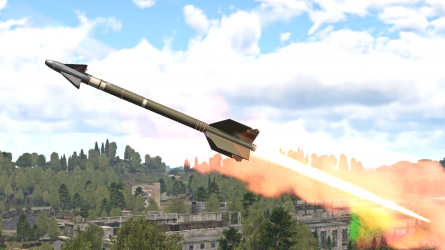Difference between revisions of "MIM-72"
m (Correction) (Tag: Visual edit) |
iCEREAlPlツ (talk | contribs) m (→Pros and cons) (Tag: Visual edit) |
||
| Line 52: | Line 52: | ||
'''Pros:''' | '''Pros:''' | ||
| − | * The MIM- | + | * The MIM-72G variant is smokeless, making them harder to be spotted by enemy aircraft |
* Features relatively good flare resistance | * Features relatively good flare resistance | ||
* Has a high explosive mass, knocking out most planes with a direct hit | * Has a high explosive mass, knocking out most planes with a direct hit | ||
Latest revision as of 20:16, 17 October 2024
Contents
Description
The MIM-72 is a US Surface to Air missile that can be found on the Imp.Chapparal in the american and israeli tech tree. The Missile comes in 4 variants: The american chapparal features the MIM-72C and E while the israeli has acces to the MIM-72E and G variants.
Vehicles equipped with this weapon
General info
| Missile characteristics | |
|---|---|
| Calibre | 127 mm |
| Mass | 86.3 kg |
| Guidance | IR, Rear-Aspect |
| Maximum speed | 720 m/s |
| Maximum overload | 16.5 G |
| Firing range | 6 km |
| Missile guidance time | 60 secs |
| Explosive mass | 4.31 kg TNTeq |
| Fuse delay | 1 m |
| Fuse sensitivity | 0.3 mm |
| Trigger radius | 5 m |
Effective damage
Describe the type of damage produced by this type of missile (high explosive, splash damage, etc)
Comparison with analogues
The MIM-72 is similar to the american FIM-92 Stinger missile and the soviet 9M37M missile.
Usage in battles
The MIM-72's effectiveness highly depends on the target and its orientation relative to the launcher. Due to the MIM-72's low G overload it is best used against slower, less agile and distant targets. Though not very effective against distant helicopters, the missile has a very sensitive IR seeker and can detect almost anything.
Pros and cons
Pros:
- The MIM-72G variant is smokeless, making them harder to be spotted by enemy aircraft
- Features relatively good flare resistance
- Has a high explosive mass, knocking out most planes with a direct hit
Cons:
- Low all-aspect range
- Limited overload making close-range hits almost impossible
History
Examine the history of the creation and combat usage of the weapon in more detail than in the introduction. If the historical reference turns out to be too long, take it to a separate article, taking a link to the article about the weapon and adding a block "/History" (example: https://wiki.warthunder.com/(Weapon-name)/History) and add a link to it here using the main template. Be sure to reference text and sources by using <ref></ref>, as well as adding them at the end of the article with <references />.
Media
Excellent additions to the article would be video guides, screenshots from the game, and photos.
See also
Links to the articles on the War Thunder Wiki that you think will be useful for the reader, for example:
- reference to the article about the variant of the weapon;
- references to approximate analogues by other nations and research trees.
External links
Paste links to sources and external resources, such as:
- topic on the official game forum;
- other literature.




